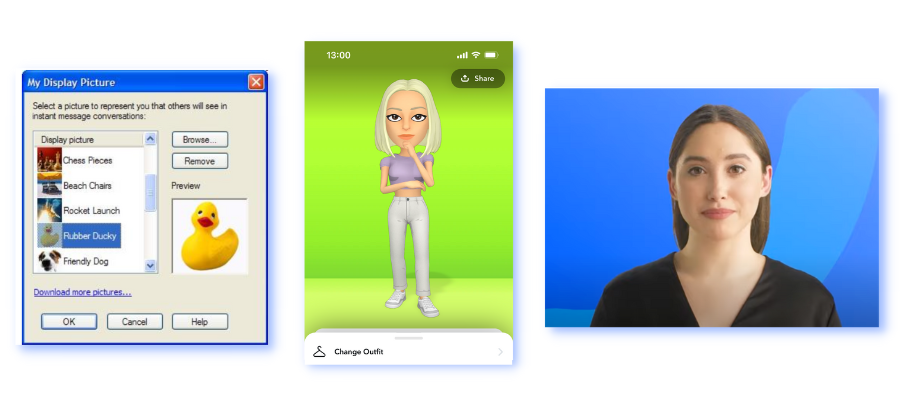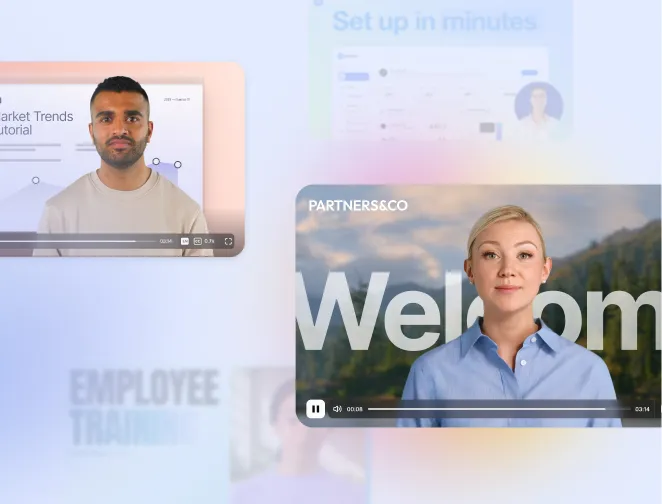
Create AI videos with 230+ avatars in 140+ languages.
People connect with faces, not text.
Digital humans bring expression, gaze, and nuance to AI-generated content, bridging the gap between automation and authentic human communication.
In this guide, I’ll show you where they work, how to build them in Synthesia, and how to roll them out responsibly with metrics and guardrails.
What are digital humans?
Digital humans are human-like virtual beings that represent people or brands in digital environments. When you see "digital humans" in this article, we're referring to AI-generated presenters and conversational agents that look and sound human.
Think of them as a sophisticated evolution of animated avatars. While avatars can be cartoonish or abstract, digital humans are photorealistic—they're designed to be indistinguishable from real people. This realism isn't just about appearance; it's about creating genuine connections through communication.
Digital humans operate through three integrated layers:
- Visual persona: Face and body rendering, lip-sync, gaze tracking, and natural gestures
- Voice: Neural text-to-speech or consented voice cloning for authentic speech
- Intelligence: Scripted logic or LLM-driven dialogue for context-aware responses
They can appear in different deployment modes depending on your needs. Pre-rendered videos offer the highest fidelity and brand control—perfect for training modules or marketing content. Real-time "live" avatars enable two-way interaction for customer support. Embedded agents work inside apps and websites for guided experiences.
Fun fact: The digital human journey
The first complete "digital human" figure, "Boeing Man," dates back to 1964 for cockpit testing. We've come a long way from those early wireframe models to today's photorealistic presenters. You can learn more about digital human history here.
Digital humans can represent two distinct identities: they can be digital twins of real people (based on their actual appearance and voice) or fictional characters (created from actors or entirely AI-generated). Both serve different purposes in modern communication strategies.
What do digital humans do?
If you're battling long production cycles, low engagement in training, or inconsistent messaging across markets, digital humans give you a consistent face and voice you can update in hours—not weeks. They recreate human interaction at scale, addressing the fundamental need for personal connection in digital communication.
Non-verbal cues like gaze, facial micro-expressions, and prosody are critical to how we build rapport and understand intent—especially on video. Digital humans leverage these elements to create more engaging experiences. Faces and voices increase attention and recall in procedural content, which is why you're seeing them used for complex explainers and training materials.
Beyond training, digital humans excel at providing personalized experiences across various touchpoints. They can guide customers through troubleshooting processes, deliver leadership messages with consistent tone and presence, or present product demonstrations in multiple languages—all while maintaining the human element that text-based systems lack.
Where are digital humans used?
Digital humans are rapidly entering everyday business operations, with the digital human economy projected to exceed $125 billion by 2035. Here's where they're making the biggest impact:
- Customer support: A "face on the FAQ" guiding troubleshooting and hand-offs, reducing ticket volume for common issues
- Training & L&D: Compliance refreshers, product how-tos, role-play scenarios that are easy to update and localize
- Healthcare assistants: Patient education and navigation with human oversight and regulatory safeguards
- Marketing & sales: Product tours, announcements, and regionalized explainers that ship in multiple languages
- Internal communications: Consistent delivery of leadership messages and change-management updates

How do you make a digital human using artificial intelligence?
Creating a digital human is more straightforward than you might think. Here's the streamlined workflow:
- Choose your avatar type: Personal avatar (your likeness), studio avatar (professionally captured), or a "stock" avatar (based on actors)
- Provide a few minutes of on-camera footage (in a studio, or on your webcam or phone) and provide consent
- The system trains lip-sync, gaze, and micro-gestures; you select a voice (AI voices or multilingual voice cloning)
- Generate videos from text; use dialogue for multi-speaker scenes; adapt to new markets with 1-click translation
Incredible examples of digital humans
Several companies are pioneering the digital human space, each with unique strengths for different use cases.
1. Synthesia's Expressive Avatars
Expressive AI avatars capture tone and nuance, natural body movement, and human-like mannerisms—so presenter-style videos feel more lifelike. Teams replace reshoots with text edits and spin up localized variants in minutes.
2. MetaHumans by Unreal Engine
MetaHumans represent a breakthrough in digital human technology for gaming and film. These highly realistic 3D characters simulate human appearance with exceptional detail. Pick MetaHuman for ultra-realistic, real-time 3D characters in games and cinematic productions.
3. Digital Humans by UneeQ
UneeQ offers AI-powered characters for interactive customer service across healthcare, finance, and retail. Pick UneeQ for real-time, conversational retail or banking experiences where two-way dialogue is essential.
What are the technologies used in developing digital humans?
Creating convincing digital humans requires a sophisticated blend of technologies that address both appearance and communication:
- Motion capture to serve as a basis for 3D modeling
- 3D modeling to create realistic face and body representations
- Natural language processing to understand voice commands and context
- Natural language generation to form appropriate responses
- Artificial intelligence to process input and learn from patterns
Two key distinctions shape how digital humans are deployed:
- Pre-rendered vs real-time: Use pre-rendered when fidelity, brand approvals, and localization matter; use real-time when latency and two-way conversation are core
- Scripted vs LLM-driven: Scripted for accuracy and compliance; LLM-driven when you need retrieval, Q&A, and tool use—always with guardrails
The uncanny valley
The uncanny valley occurs when a synthetic human looks almost real but something feels slightly off, causing unease. It's best to tune blink and gaze rates, reduce extreme head motion, and align pauses to visual beats to avoid that "robotic" feel.
Why do we need digital humans?
Digital humans address real business challenges while augmenting teams rather than replacing them. Here's the value they deliver:
- Operate 24/7 without scheduling constraints—perfect for global teams and customers
- Consistent, on-brand delivery across regions and languages
- Faster updates when policies, pricing, or processes change
- Enhanced accessibility: captions, multilingual delivery, and culturally appropriate presenters
- Safe spaces for sensitive topics with clear disclosure
Be sure to keep humans in the loop for high-stakes topics and make it obvious when users are engaging with AI. This transparency builds trust while leveraging the efficiency benefits of digital human technology.
What are the risks of digital humans?
Like any transformative technology, digital humans come with considerations that require thoughtful implementation:
1. The uncanny valley
When people realize they're interacting with AI, trust can erode.
Mitigation: User testing, style tuning, and preferring pre-rendered content for critical communications.
2. User privacy
Human-like interactions may lead to oversharing of personal information.
Mitigation: Data minimization, consent capture, and secure log storage.
3. Ethics and bias
Stereotypes can surface in avatar selection and representation.
Mitigation: Diverse avatar library, local cultural review, and avoiding stereotypical portrayals.
4. Human interactions
Over-reliance on digital humans could impact genuine human connections.
Mitigation: Clear AI disclosure and easy routing to human support.
5. Identity and deepfakes
Potential for misuse in creating unauthorized representations.
Mitigation: Watermark AI videos, provenance logging, and contractual controls on likeness use.
Implementation playbook
Ready to get started with digital humans? Follow these five steps for successful implementation:
- Pick one high-value use case (e.g., onboarding module or FAQ explainer)
- Draft for speech (short lines, one idea per sentence, add emphasis cues)
- Choose avatar type and voice; run a cultural and brand check
- Pilot in one market; measure completion rate, dwell time, and CSAT
- Localize with 1-Click Translation; roll out variants; set governance rules
The future of human interaction
Digital humans are already humanizing virtual interactions and impacting how businesses operate. Expect agentic video—digital humans that can ask clarifying questions, query your knowledge base, and take actions. You'll see fewer "watch-only" videos and more "do-with-me" flows that guide users through complex processes.
Individuals are taking on new forms of digital identities. Businesses are accelerating their communications. Society is entering a new era of social interaction.
The technology is ready. The question is: are you? Try creating an AI-generated video with a digital human to see what's possible. Please disclose when content is AI-generated and use consented likenesses only.
About the author
Content Writer & Marketing Expert
Ema Lukan
Ema Lukan is a seasoned Content Writer and Marketing Expert with a rich history of collaborating with marketing agencies, SaaS companies, and film studios. Her skill set encompasses copywriting, content creation, and a profound understanding of the intricate fabric of brand identity. Ema distinguishes herself not merely as a wordsmith but as a storyteller who comprehends the power of narratives in the digital landscape. Fascinated by new technologies, she navigates the evolving marketing terrain with creativity and analytical precision, leveraging data to refine strategies. Her passion lies in crafting compelling stories that resonate, always mindful of the ever-changing dynamics in the digital world and the culture shaping it.

Frequently asked questions
What is a digital human?
A digital human is a photorealistic virtual being that looks, sounds, and communicates like a real person through AI technology. Unlike basic avatars or chatbots, digital humans combine lifelike appearance with natural speech, facial expressions, and body language to create authentic connections in digital environments.
These AI-powered presenters can represent real people as digital twins or exist as fictional characters, serving as the face of your brand across training videos, customer support, and marketing content. By recreating human interaction at scale, digital humans bridge the gap between automated efficiency and the personal touch that builds trust and engagement in business communications.
What are practical examples of digital humans in business today?
Digital humans are transforming how businesses communicate across multiple touchpoints. In customer support, they serve as always-available representatives who guide users through troubleshooting processes with a friendly face, reducing ticket volume for common issues. For learning and development teams, digital humans deliver consistent compliance training and product demonstrations that can be updated instantly and localized for global audiences.
Marketing teams use digital humans to create personalized product tours and announcements that ship in multiple languages without reshooting. Healthcare organizations deploy them for patient education with appropriate oversight, while internal communications teams ensure leadership messages maintain consistent tone and presence across all regions. These applications demonstrate how digital humans make professional video content scalable and accessible for teams of any size.
How do I create a digital human with Synthesia?
Creating a digital human with Synthesia takes just minutes and requires no technical expertise. You can choose from over 230 professionally captured studio avatars, or create a personal avatar by recording 15 minutes of footage using your webcam or phone. After providing consent for your likeness, the AI processes your footage to create a digital twin that captures your appearance and can speak in your voice or any of the available AI voices.
Once your digital human is ready, simply type your script and the platform generates a video with natural speech, expressions, and gestures. You can create multi-speaker dialogues, add screen recordings, and adapt content for new markets with one-click translation. This streamlined process transforms weeks of traditional video production into hours, making it practical for teams to maintain fresh, localized content across all their communications.
Can digital humans speak multiple languages for global audiences?
Digital humans in Synthesia can communicate fluently in over 140 languages and accents, making them ideal for global business communications. The platform combines AI voice generation with precise lip-syncing and culturally appropriate gestures, ensuring your digital presenter appears native in each language rather than dubbed. You can create content once and translate it instantly, maintaining consistent messaging while adapting to local markets.
This multilingual capability extends beyond simple translation to include voice cloning, where your digital twin can speak languages you don't know while maintaining your unique voice characteristics. Teams use this to deliver training in employees' native languages, create region-specific marketing content, and ensure customer support feels personal regardless of location. The result is truly global communication that maintains the human connection essential for building trust across cultures.
How does Synthesia ensure consent and transparency when deploying digital humans?
Synthesia implements strict consent protocols to prevent unauthorized use of anyone's likeness or voice. Before creating a personal avatar, individuals must provide explicit consent through either in-person verification for studio captures or secure online processes for webcam recordings. The platform verifies not just that someone is human, but that they are the specific person whose likeness is being captured, preventing non-consensual deepfakes.
For deployment, Synthesia advocates clear AI disclosure so viewers know when they're watching AI-generated content. The platform includes watermarking capabilities and maintains provenance logging to track content creation and usage. These safeguards, combined with policy filters that prevent inappropriate content generation and human review requirements for sensitive topics, ensure digital humans enhance rather than deceive in business communications. This ethical framework builds trust while leveraging the efficiency benefits of AI video technology.














